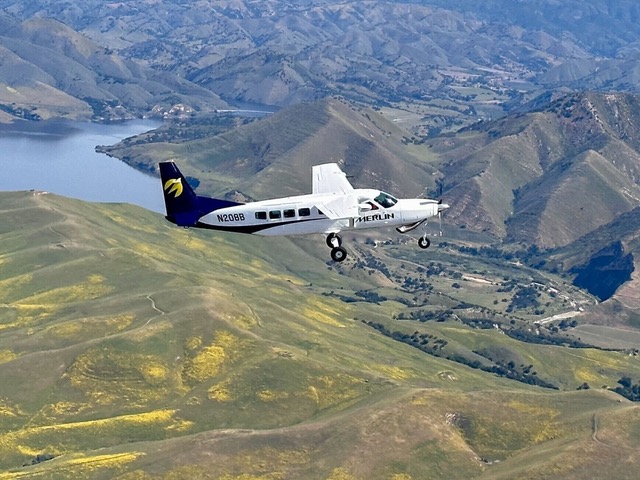MATT GEORGE, CEO & FOUNDER
01
We Are Merlin
Merlin was founded in 2018 with a vision to deliver on the promise of autonomous flight. More than 27,000 commercial aircraft operate today to connect the world, reunite families, and protect democracy. Yet, as society becomes increasingly more globalized, so too does the world’s dependency on air transportation. With that demand, autonomous flight solutions are more relevant and needed given their ability to support a more flexible and scalable aviation ecosystem.
After closely watching the race to deploy autonomous vehicles, I realized that innovation in autonomous ground transportation could also transform the future of air transportation. As a certified pilot myself, I saw the best way to successfully – and safely – scale autonomous flight was to take a practical, phased approach that first pairs the advanced automation capabilities with a human pilot. To achieve this, we designed and built the Merlin Pilot, which leverages the skills of a human pilot and translates them into software.
Our Mission and Technology
Our mission is to create the world’s most capable pilot leveraging technology as the key enabler of air network resiliency. At Merlin, we do not believe that autonomy is an all or nothing approach – with all autonomous or all humans. Instead, we see technology and the human pilot together as the answer and a critical first step in building trust on the path to a fully autonomous future. We are stewards of that relationship.
The Merlin Pilot is an integrated hardware and software solution that makes Human Factor-driven decisions that enable it to transcend unexpected, environmental, or experience-based impacts on mission success. It can support many scenarios from assisting crew in dangerous missions to enabling crew reduction on large aircraft. It’s also platform-adaptable, making it easy to implement across fleets of any size, with a diverse range of aircraft, while remaining open to future technological capabilities.
The Merlin Pilot’s technical capabilities allow it to assist and augment existing pilots in flight. It does this by using a wide range of sensor technology to understand the aircraft’s state and its surrounding environment, making it capable of navigating and recommending trajectory adjustments as needed. Its communications system is also equipped with Natural Language Processing (NLP) algorithms so that it can communicate with air traffic control the same way a human pilot does.
Our Role in Accelerating an Autonomous Future
Our thoughtful, three-phased philosophy ensures safety and scalability as we accelerate toward a future of autonomous flight.
- Crawl. Rigorous testing and certification with industry regulators including the U.S. Federal Aviation Administration and the Civil Aviation Authority of New Zealand.
- Walk. Reduced crews on small aircraft, using a teaming approach whereby the Merlin Pilot and the human safety pilot aboard validate the Merlin Pilot’s data-driven decisions and ensure safety.
- Fly. Large aircraft fly with the Merlin Pilot and a reduced crew, and small aircraft fly without a crew.
This unique and pragmatic approach to autonomy is what distinguishes both the Merlin Pilot’s near-term scalability and certification path in the industry. We’ve worked closely with the U.S. Federal Aviation Administration (FAA) and the Civil Aviation Authority of New Zealand (CAA) to ensure the Merlin Pilot achieves safety critical certifications, and have accomplished significant milestones thus far. Those milestones include becoming one of the first companies to be issued a certification basis for a takeoff-to-touchdown advanced automation system, as well as achieving the CAA’s first stage of involvement (SOI 1), which laid the groundwork for the Merlin Pilot to be the first advanced automation system validated by the FAA.
We’ve also formed significant partnerships over the years with Dynamic Aviation to bring autonomy to the world’s largest fleet of Beechcraft KingAirs; Ameriflight, the largest Part 135 cargo airline in the United States, to bring autonomous and semi-autonomous flight capabilities to its fleet; and the United States Air Force to bring autonomy to some of the service’s transport aircraft.
Delivering a dependable, adaptable, and scalable autonomous solution is also predicated on building trust and time underwing. To date, the Merlin Pilot has flown 500+ systems-on missions, spent over 800 hours in the sky, and been integrated on five different aircraft types. Earlier this year, we successfully completed our FAA-contracted, Alaska-based flight trials for the nation’s first air cargo network flown by a non-human pilot, in conjunction with a safety pilot, following a $1 million contract with the FAA. With over 60 hours of systems-on flight time, we were able to collect extensive data in a real world environment with complex terrain and inclement weather. This data is essential to not only maturing the Merlin Pilot’s in-flight capabilities but also progressing autonomy more broadly for the aviation industry.
What’s Ahead
With offices in Boston and Denver, our team will continue innovating and making historical leaps in aviation. This includes ongoing technological development and certification activities at our Mojave, CA and Kerikeri, NZ test facilities.
While making significant traction in commercial aviation, we’re also proudly growing our work in the defense market where there is immense opportunity and need for mission critical technology. The Department of Defense will always look at the efficiency of how they transport goods via aircraft, and our work to date has shown the Merlin Pilot to be a promising solution that can meet evolving airspace needs and enhance national security.
Lastly, we’re hiring! As we grow and build, we’re looking for innovative thinkers who want to be pioneers in the aviation field to join our growing team. You can learn more about working at Merlin and view job openings here.
